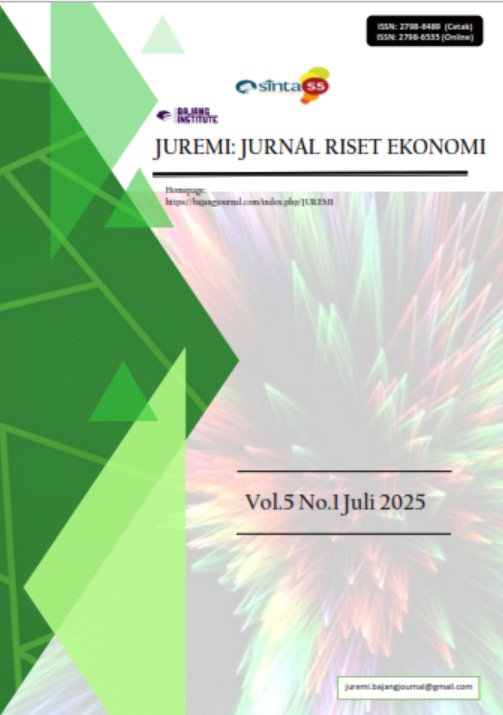ANALISIS KUALITAS KONTEN INSTAGRAM PRIDECHICKEN TERHADAP KESADARAN MEREK DAN NIAT PEMBELIAN
DOI:
https://doi.org/10.53625/juremi.v5i1.11069Keywords:
Kualitas Konten, Kesadaran Merek, Niat PembelianAbstract
Perkembangan industri teknologi pada saat ini membuat banyak bisnis yang kini memanfaatkan media sosial sebagai sarana digital untuk menyampaikan informasi atau mempromosikan produk mereka secara luas. Salah satu bisnis yang saat ini sedang melakukan pemasaran digital secara massif melalui Instagram adalah Pride Chicken, sebuah bisnis yang bergerak di bidang kuliner. Penelitian ini berfokus pada pengujian pengaruh kualitas konten terhadap kesadaran merek dan niat pembelian. Peneliti membangun penelitian ini dengan menggunakan metode kuantitatif dengan data sampel sebanyak 100 dari responden di seluruh Indonesia yang mengetahui konten Instagram Pride Chicken, Menggunakan Structural Equation Modeling (SEM) dengan bantuan software SmartPLS, analisis data menemukan bahwa kualitas konten berpengaruh positif dan signifikan terhadap kesadaran merek dan niat pembelian
References
Pandjaitan, R. H. (2024). The Social Media Marketing Mix Trends in Indonesia for 2024: Communication Perspective. Jurnal Komunikasi Ikatan Sarjana Komunikasi Indonesia, 9(1), 251–269.
Virtanen, H., Björk, P., & Sjöström, E. (2017). Follow for follow: marketing of a start-up company on Instagram. Journal of Small Business and Enterprise Development, 24(3), 468–484.
Cvijikj, I. P., & Michahelles, F. (2013). Online engagement factors on Facebook brand pages. Social Network Analysis and Mining, 3(4), 843–861
Teo, L. X., Leng, H. K., & Phua, Y. X. P. (2019). Marketing on Instagram: Social influence and image quality on perception of quality and purchase intention. International Journal of Sports Marketing and Sponsorship, 20(2), 321–332
[5] Erwin, E., Suade, Y. K. M., & Alam, N. (2023). Social Media Micro-enterprise: Utilizing Social Media Influencers, Marketing Contents and Viral Marketing Campaigns to Increase Customer Engagement (hlm. 578–593).
Carlson, J., Rahman, M., Voola, R., & De Vries, N. (2018). Customer engagement behaviours in social media: capturing innovation opportunities. Journal of Services Marketing, 32(1), 83–94.
Buckley, M., Chen, J., Durkheimer, M., Krohnstad, H., Liu, H., Mcdevitt, L., Pirani, A., Pollack, J., Wang, R., Bazerman, M., Beshears, J., Haidt, J., Heath, C., Kashima, Y., Keltner, D., Peters, K., Schaller, M., Small, D., Stephen, A., Milkman, K. L. (2012). What Makes Online Content Viral? Journal of Marketing Research, XLIX, 192–205.
Kingsnorth, S. (2016). Praise for Digital Marketing Strategy. Kogan Page.
Akbar, M. F., Ati, H. D. L., & Sukarson, A. (2024). Peran Tiktok Dalam Meningkatkan Brand Awareness Di Kalangan Milenial Dan Gen Z. Journal Media Public Relations, 4(1), 52–57.
Ambolau, M. A. P., Kusumawati, A., & Mawardi, M. K. (2015). The Influence of Brand Awareness And Brand Image On Purchase Decision. Jurnal Administrasi Bisnis, 2(2), 1–8.
Utama, A. P., Sihaloho, S., & Nabila, S. N. (2023). Strategi Membangun Kesadaran Merek Dalam Mencapai Keberlanjutan Bisnis. Ikra-Ith Abdimas, 7(3), 160–165.
Chen, Mei-Fang, & Chia-Lin Lee. (2015). The Impacts of Green Claims on Coffee Consumers’ Purchase Intention. British Food Journal, 117(1), 195-209.
Matthews, L., Eilert, M., Carlson, L., & Gentry, J. (2020). When and how frontline service employee authenticity influences purchase intentions. Journal of Business Research, 114, 111–123.
Gelard, P., & Negahdari, A. (2011). A new framework for customer satisfaction in electronic commerce. Australian Journal of Basic and Applied Sciences, 5(11), 1952-1961.
Zhang, R., & Tran, T. (2011). An information gain-based approach for recommending useful product reviews. Journal of Knowledge and Information Systems, 26(3), 419-434.
Rahim, K., & Clemens, B. (2012). Organizational Goals and Performance Measurement Criteria for Content Marketing. Journal of Communication and Computer (Vol. 9).
Ashrafa, M. U., Nawaz Khanb, S., & Ansaric, A. A. (2022). Impact of Brand Awareness and Social Media Content Marketing on Brand Loyalty: The Mediating Role of Brand Trust. Journal of Organization & Business, 3(1).
Nosrati, M., Karimi, R., Mohammadi, M., & Malekian, K. (2013). Internet Marketing or Modern Advertising! How? Why? International Journal of Economy, Management and Social Sciences, 2(3).
Järvinen, J., & Taiminen, H. (2016). Harnessing marketing automation for B2B content marketing. Industrial Marketing Management, 54, 164–175.
Cooper, R. C. & Schindler, P. S. (2014). Business Research Methods, 12th Edition. New York: McGraw-Hill.
Schmidt, S., & Eisend, M. (2018). Advertising Repetition: A Meta-Analysis on Effective Frequency in Advertising Repetition. November.
Hair Jr, J. F., Black, W.F., Babin, B. J. & Anderson, R. E. (2010), Multivariate Data Analysis, A Global Perspective, 7th edition, Upper Saddle River, New Jersey: Pearson Education, Inc.
Cheung, M., Pires, G. & Rosenberger, J. (2019), Developing a conceptual model for examining social media marketing effects on brand awareness and brand image. International Journal of Economics, 17(3).
Agmeka, F., Wathoni, R. N., & Santoso, A. S. (2019), The influence of discount framing towards brand reputation and brand image on purchase intention and actual behaviour in e-commerce. Procedia Computer Science, 161, 851–858.
Al-Qudah, O. M. (2020), The effect of brands’ social network content quality and interactivity on purchase intention: Evidence from Jordan. Management Science Letters 10 (2020), 3135-3142.
Rahmawati, P. A., & Farida, L. (2024), The Influence of Content Marketing, Content Quality, and Brand Image on the Purchase Intention of Skintific Products Through the Official TikTok. Journal of Economics, Education and Entrepreneurship, Vol. 5, No. 2, August 2024, pp. 168-180.
















